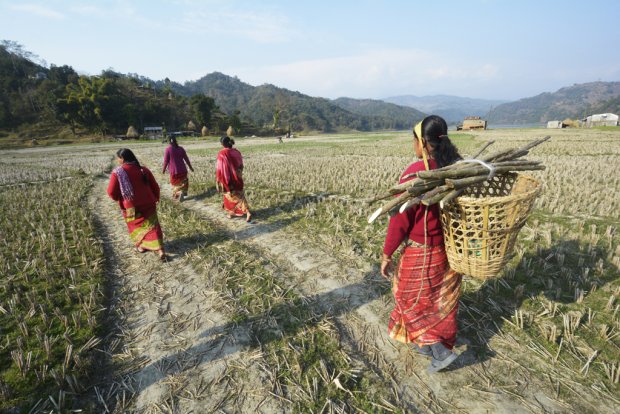Climate Change Vulnerability: In Nepalese Agriculture


Nepal is a landlocked country of variable Geographical region and tough topographic barrier, consisting total area of 147,181 km2 (56,827 sq. mi) in south Asia. Nepal derived of three strikingly contrasted land areas i.e. terrain (17%), hill (68%) and mountain (15%) each with distinct climate and agriculture practices. In Nepal total agriculture land is 2.7 million hectares (28.6% of total land) where as arable or cultivable land is 16% of total land but out of which only 1.3million hectares have irrigation facilities.
Almost 65% of agricultural land is rainfed(MOPE,2000). Yet only 21% of land were cultivable and the irrigable agricultural land depends upon the local resource, were affected by erratic rainfall. For Nepal’s population demanded food, climate change has been implication as major challenge. 70% of Nepalese people strictly depend upon agriculture for daily live hood and economy and accounting for about one-third of GDP. According to world bank, Nepal contribute 32.979% GDP in 2016(the world bank) but recent study funded by the climate and Development Knowledge Network (CDKN) revealed that about 0.8% of agriculture GDP is being lost annually due to climate change and extreme events.
Nepal’s varied topography and social vulnerability make the country particularly susceptible to geological and climate-related disasters. Insufficient mechanization and strength for dealing with natural disasters exacerbates such critical situation. Erratic weather patterns, elevating temperature, heat and drought stress to plant, soil erosion, landslides, flash floods, heavy precipitation and emission of CH4, CO2 and NH3 gas along with global warming, alarmingly affecting the agriculture crops.
Nepal lies under 4th ranked as vulnerable country index, It’s the serious challenge for such under developing and tough topographic barrier country. In 2016/17 due to low rainfall 10% of land were remain baked and suffered form drought condition. Heavy rainfall and flooding during august 11, 2017 culminative devastation of agriculture product and land. Rice, Wheat, maize and many cereal crops usually cultivated in terrain Region, is most vulnerable to natural disaster. Due to prolong dry and future irrespective change un total annual precipitation, widespread damage of agriculture evident were common. Severe “Cold wave” during winter season devastate winter vegetable crops of Terrain and mid-hill. Two-sevenths of the total land is cultivated, of which 1.5 million hectares produced 3.7 million metric tons of the staple crop (/knowledge/Staple_food.html) of rice in 1999. Wheat and maize (/knowledge/Maize.html) together take up a similar portion of the available land, with harvests of 1 million metric tons and 1.5 million metric tons, respectively, in 1999.
FAO (2006) reports that climate change will affect all four dimensions of food security, namely food availability, access to food, the stability of food supplies and food utilization. Climate variability and change could lead to vulnerability of various resistance disease, virus and plant pathogen. People may suffer malnutrition (60% child die) through a combination of reduced food production, increase food prices, and lower food utilization due to increased infections, hunger (30-40% in 2007 Nepalese people were hunger) and more intense and frequent climate-related disasters.
Agriculture is arguably the sector most affected by climate change, but impact assessments differ and thus are difficult to compare. As the Nepalese population growing by 1.13% and reaches up to 31million by 2022 (the world bank), along with changing climate mystify selection of crop types, regions, farming practices and policies. In 1999 Shrestha et al. suggested that temperatures are increasing in Nepal and that rainfall is becoming more variable. In 2010 Nepal’s National Adaptation Plan of Action (NAPA) has recognizes that climate change will be uncertain, and vulnerability may occur.
According to MOAC, Nepal’s average annual mean temperature have been increasing by 0.04-0.060C, trend to increase 1.20C by 2030 and 1.70 C by 2050. Glacial lake was expanding due to glacier melt. Precipitation events were increasing, occurrence of intense rainfall, more variable river flows and winter precipitation trends along with summer monsoon is likely to become more by 5-10% in eastern Nepal.
Climate change execute cereal crop, which was 9.4 million metric ton by 2012 and decrease to 8.5 million metric ton by 2013 (the world data) reveal of late sowing and delay pre-harvesting practice. Cereal crops being a staple crop devoted about one half of the arable land during the growing season and contributes 76 percent of total crop production. In 2009, transplanting of paddy was delayed ascribable to weak and linger summer monsoon, and in the same year heavy rain and flooding occurred during harvesting period engender a damage of 20-25% on paddy production in most parts of the country.
Strategies: -
1) Mobilized agriculture relief schemes towards natural calamities disaster and entrenched active surveillance system to assess the impact of disease pathogen, heavy rainfall and drought.
2)Ensuring the data driven farming system, along with actual data of specific crop facilitate the farmer to understand cropping period, management practices (timely watering, manuring and hoeing to weeding) pre-harvesting and post harvesting storage.
3)Inaugurate a special program focusing local group by encouraged them production of food grain.
4)Agriculture crop insurance program should be extended, high value agricultural products need to gradually introduce for insurance.
5)Minimizing the excess use of agricultural chemical on soil and water bodies.
6)Specially in drought area installation of small irrigation infrastructure such as solar water pump, drip irrigation, pedal pump, rower pumps, sprinklers, plastic water harvesting pond and monsoon overflow roof water harvesting tank facilities specially in hilly region should be provided to targeted group.
7) Safety nets (food and nutrition) should be gradually provided to those farmer with less than half a hectare of un-irrigated land along with landless and marginal farmer, lacking alternative employment opportunities at the time of climatic hazard.
Bikram is studying 4th semester in Agriculture at Agriculture and forestry University, Rampur ,Chitwan.

 Bikram Nepali
Bikram Nepali


Feedback